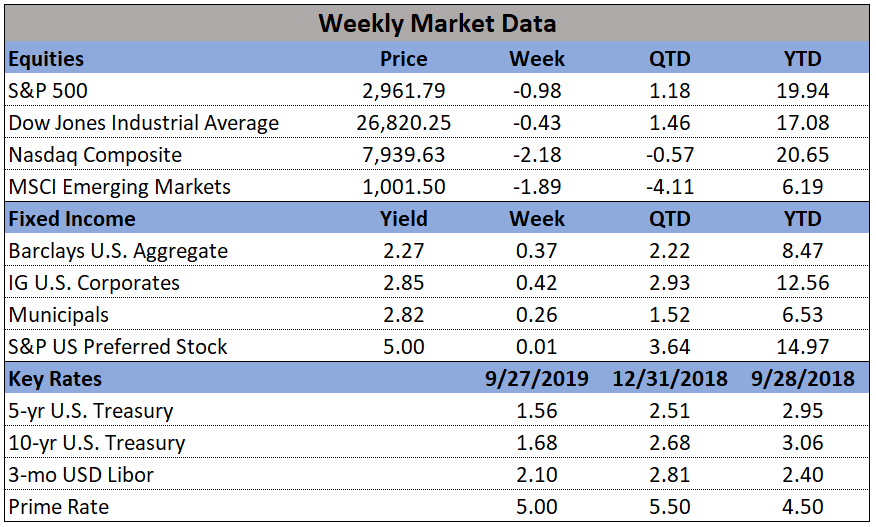The major U.S. benchmarks ended the week mixed with large cap indexes far outperforming smaller cap indexes and the technology-heavy NASDAQ Composite finishing down.
U.S. Markets: One of the week’s most notable events was Facebook’s dramatic 19% plunge following a disappointing earnings report that wiped $120 billion from its market cap. The Dow Jones Industrial Average rose 393 points on the week, closing at 25,451 - a gain of 1.6%. The NASDAQ Composite retreated for a second week, falling 1.1% to close at 7,737. The large cap S&P 500 added 0.6% while the mid cap S&P 400 and small cap Russell 2000 went the other way, ending down ‑1.2% and ‑2.0%, respectively.
International Markets: Canada’s TSX fell a second consecutive week, retreating -0.3%, while the United Kingdom’s FTSE rose for a third week in a row, up 0.3%. On Europe’s mainland, France’s CAC 40 and Germany’s DAX gained 2.1% and 2.4%, while Italy’s Milan FTSE added 0.7%. In Asia, China’s Shanghai Composite rallied 1.6% and Japan’s Nikkei ended the week essentially flat, up just 0.07%. As grouped by Morgan Stanley Capital International, developed markets added 1.1% last week, while emerging markets rose 1.7%.
Commodities: Gold continued its sell-off, now down six out of the last seven weeks. Gold finished the week at $1223.00 an ounce, a loss of -0.7%. Silver traded down -0.4%, ending the week at $15.49 an ounce. Energy, though, had a positive week after three consecutive down weeks. West Texas Intermediate crude oil rose 0.6% finishing the week at $68.69 a barrel. Copper rebounded after falling for six consecutive weeks, finishing up 1.7%. With its variety of uses, the industrial metal is sometimes referred to as “Dr. Copper” by analysts for its ability to forecast global economic health.
U.S. Economic News: The number of people seeking new unemployment benefits rose last week after hitting a 48-year low. The Labor Department reported initial jobless claims climbed by 9,000 to 217,000 in the week ended July 21, but below the 219,000 economists had estimated. The more stable monthly average of new claims fell by 2,750 to 218,000. Overall, the labor market continues to be solid with job growth stronger so far this year than last year. In addition, continuing claims, which counts the number of people already receiving unemployment benefits, fell by 8,000 to 1.75 million. That number is reported with a one week delay.
The number of existing homes sold slid for a third consecutive month in June, hitting a 5-month low as the housing market continues to slow. The National Association of Realtors (NAR) reported existing home sales ran at a seasonally-adjusted annual rate of 5.38 million in June. The number was in line with consensus estimates but down 2.2% from the same time last year. At the current sales rate, it would take 4.3 months to exhaust the available inventory—significantly below the six months that is generally considered a balanced housing market. Homes were on the market for an average of 26 days in June. The median price of a home sold in June was $276,900—a new all-time high, and up 5.2% from June 2017. Higher prices and higher mortgage rates appear to be weighing on buyers. Sales were mixed regionally in the NAR report, rising 5.9% in the Northeast and 0.8% in the Midwest, but off 2.2% in the South and 2.6% in the West.
Along with existing home sales, sales of new homes also slid in June as higher mortgage rates, increasing home prices, and relatively few available homes weighed. The Commerce Department reported new home sales ran at a 631,000 annualized pace last month, missing economists’ forecasts of 660,000. From May, sales of new homes plunged 5.3%, but remain 2.4% higher than the same time last year. The median price of a new home sold during the month was $302,100, 4.2% lower than in June 2017. Year-to-date, sales are up 6.9% from the same time last year, but many housing analysts have suggested that there’s little momentum left in the market. At the current rate of sales, there is a 5.7 months’ supply of homes available on the market--the most since last summer. Analysts noted that the Commerce Department’s data is often heavily-revised and that it will likely take a few more months before clear trends emerge.
Research firm IHS Markit reported both the manufacturing and services sides of the economy showed steady and rapid growth in July in its latest preliminary, or “flash”, reading. The seasonally adjusted preliminary IHS Markit U.S. Composite Purchasing Managers’ Index (PMI) fell to 55.9 in July. Markit’s manufacturing index rose a tick to 55.5, while the services index slipped 0.3 point to 56.2 (readings over 50 indicate expansion, below 50 indicate contraction). The latest PMI report indicates the economy continued to expand at a healthy pace mid-summer despite the heightened concerns over global trade. Markit noted the biggest single worry for companies is rising prices. Higher input costs were passed on to consumers at the fastest pace since the firm began compiling reports in the fall of 2009.
Orders for goods expected to last longer than 3 years, so-called “durable goods”, rose 1% last month - the first increase in three months, according to the Commerce Department. In the details of the report, transportation equipment orders led the increase, rising 2.2% in June. Civilian aircraft orders rose 4.3% following an 11.6% drop in May. Orders for autos rose 4.4%, essentially reversing the 4.5% drop the prior month. Minus transportation, orders were up 4%, and excluding defense-related goods orders rose 1.5%. The closely-watched orders for nondefense capital goods, excluding aircraft, rose 0.6% following a 0.7% gain in May. Analysts state orders are growing at a healthy clip--year-over-year orders are up 8.4%.
A measure of the strength of the U.S. economy from the Chicago Federal Reserve rebounded last month following a sharp drop in May. The Chicago Fed’s National Activity Index came in at 0.43 for June following a -0.45 reading in May. The index’s less-volatile three-month moving average edged up to 0.16, up 0.06 point from May. In the details of the report, 45 of the 85 indicators made positive contributions in June, while 40 weighed. Notably, production-related indicators, such as factory activity, contributed 0.36 to the index, a sharp rebound from the -0.56 drag in May. The Chicago Fed’s index is a weighted average of 85 economic indicators, constructed so that zero represents trend growth and a three-month average below -0.70 suggests a recession is underway.
The U.S. economy accelerated at a 4.1% rate in the second quarter of year, its fastest in almost four years. Strong consumer and business spending, as well as a surge in exports helped drive economic growth. The reading was the third-best growth rate since the end of the Great Recession. In addition to the strong second quarter, the Commerce Department revised its reading for the first quarter up 0.2% to 2.2%. Shortly after the release, President Donald Trump stated, “We're on track to hit the highest annual growth rate in over 13 years. And I will say this right now and I will say it strongly, as the deals come in one by one, we're going to go a lot higher than these numbers, and these are great numbers." Peter Boockvar, chief investment officer at Bleakley Advisory Group noted that if it hadn’t been for a big upside to inflation, “GDP would have been much better.”
International Economic News: A Republican congressman from Wisconsin says Canada has committed “economic terrorism” by imposing tariffs on U.S. agricultural products. Wisconsin Representative Sean Duffy stated “We knew that Europe, China, Canada and Mexico would go after American Ag. That’s how they try to take us down. This is, I think, economic terrorism in a way.” Canada has imposed tariffs on more than 200 U.S. products including cucumbers, orange juice, and beef in response to President Donald Trump’s own tariffs on Canadian steel and aluminum. The Organization for Economic Cooperation and Development (OECD) stated Canada’s economy would benefit from bringing more women, youth, seniors, and immigrants into its work force. In the OECD’s biennial report, it’s recommended that among other things, Canada invest more in affordable child care, raise its retirement age, and do a better job of matching immigrants’ qualifications and experience to specific skills needs. The OECD described Canada as being among the organization’s leaders in “delivering the best outcomes for its citizens,” and lauded its strong immigration policies.
- Please visit our website www.pacificinvestmentresearch.com for more insights. Email us at info@pacificinvestmentresearch.com if you have any questions.








